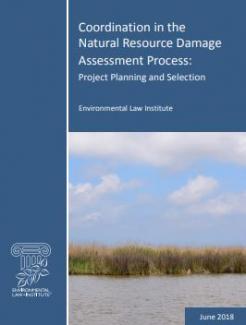ELI Report
Women in Water Institute and partners champion gender-inclusive policymaking in transboundary basins around the world
Women, young people, and vulnerable communities often experience the brunt of water insecurity and stress—a growing challenge in many areas of the world. At the same time, women are on the frontline of efforts to address transboundary water issues. Despite a gap in meaningful participation of women in the water sector, research has shown that gender-inclusive policymaking results in more durable and resilient solutions.
Since 2017, ELI has supported empowering women in water decisionmaking as a partner of the Women in Water Diplomacy Network, a program initiated by the Stockholm International Water Institute. The Network is a community of both formal and informal decisionmakers and experts, including representatives from the ministries of foreign affairs and water, civil society members, academics, and youth organization representatives. Together, the network represents over 500 years of experience and expertise in some of the world’s most water-insecure regions.
The Women in Water Diplomacy Network originally began with a focus on the Nile Basin, convening water diplomats and leaders from 11 basin countries. In 2021, the program expanded to Central Asia and Afghanistan through a partnership with the Regional Environmental Centre for Central Asia and the Organization for Security and Cooperation in Europe. Most recently, three new basin networks for the Orange-Senqu, Zambezi, and Okavango transboundary rivers in southern Africa have entered early development stages. Meanwhile, interest in the knowledge and strategies offered through the network continues to gain interest across the world, including in North America through the engagement of United States-Canada International Joint Commission.
In August 2022, Women in Water Diplomacy held its first Global Network Forum in advance of World Water Week, an annual conference held in Stockholm, Sweden. In lieu of the Network’s traditional focus on one basin at a time, the forum convened women water diplomats and experts from across Africa, Asia, Europe, and North America. The event also introduced the Network’s new global strategy, A Path Forward for Women, Water, Peace and Security. The strategy presents a five-year plan for the Network’s programming and reflects nine months of consultation across the Network’s growing constituency.
Elizabeth A. Koch, senior manager of ELI’s International Programs, led the planning, consultation, design, and drafting of the strategy in consultation with network leaders. They include Jessica Troell, director of ELI’s International Waters Program, who has supported the development of the network since its inception, including by contributing to research and trainings on topics related to water law and gender equality.
This March, the Network will continue to promote its efforts at the UN Water Conference in New York City—the first UN conference on water in almost 50 years. Events held by the initiative will include a one-day experience exchange hosted by ELI, Stockholm International Water Institute, International Joint Commission, Lincoln Institute for Land Policy, and University of Arizona. More than 50 water diplomats and water leaders from around the world are expected to join the event, with strong focus on elevating the voices of women, Indigenous, and young water leaders.
As accelerating climate change continues to exacerbate water challenges around the world, championing women’s leadership and participation is more important than ever before. To meet these challenges, the Women in Water Diplomacy Network is actively seeking partnerships and further funding to reach its global strategy objectives and support women leaders to achieve sustainable water resources for the future.
Institute analyzes policy framework for offshore wind energy
In December, ELI released the Louisiana Offshore Wind Energy Framework to support participation by Louisiana stakeholders in offshore wind energy decisionmaking. The report provides an overview of the most relevant state laws, regulations, and intergovernmental authorities affecting wind energy development off the coast of Louisiana.
Offshore wind energy production is expected to begin soon off the coast of Louisiana and elsewhere in the Gulf of Mexico. According to the National Renewable Energy Laboratory, the Gulf has the potential to generate almost 510,000 megawatts of offshore wind energy per year—twice the current energy needs of all five Gulf states. The Bureau of Ocean Energy Management—the federal agency overseeing offshore energy permitting—has announced the opening of the Gulf to wind lease sales by 2025. In October, the agency finalized the first two wind energy zones in the Gulf, which combined would have the potential to power more than 2.8 million homes.
ELI’s report was initially developed to support the work of the National Wildlife Federation’s Offshore Wind Power program and later compiled as a standalone research report. Authored by ELI Senior Attorney Amy Reed, the resource was also distributed at Tulane Law School’s inaugural Offshore Wind Conference in January. It represents a continuation of a series of offshore renewable energy framework analyses developed by ELI. The Institute previously collaborated with the states of Delaware, Maryland, and Virginia to analyze their offshore energy laws and provide recommendations for strengthening existing frameworks. Reports for the three Mid-Atlantic states were released between 2008 and 2011. ELI also published a regional Mid-Atlantic guide to offshore wind management in 2013.
As interest grows in the offshore wind potential of the Gulf region, understanding the underlying policy and legal frameworks for supporting such development is essential. Recent tax credits through the Inflation Reduction Act further bolster development of offshore wind in the Gulf and elsewhere in U.S. waters. ELI is now beginning work on a similar policy framework for the state of Texas, in response to the enthusiastic reception of its Louisiana report.
Report highlights tips for making effective state coastal policies
Under the Coastal Zone Management Act of 1972, a federal action that impacts a state’s coastal resources may be subject to a “federal consistency review.” The federal consistency provision gives participating state governments the authority to review federal activities to determine if a proposed use is consistent with the state’s own coastal management program. Federal consistency often is a state’s best tool for influencing federal and federally approved activities that affect its coast.
At the heart of the federal consistency authority are enforceable policies: state rules that define permitted uses in and affecting a state’s designated “coastal area.” Although there are some qualifiers and exceptions, in general federal actions cannot violate or contradict enforceable policies. In December, ELI published Strong Enforceable Policies—Examples and Tips. Authored by ELI Senior Attorneys Amy Reed and Adam Schempp, the report highlights good examples of enforceable policies in the states of California, Florida, Mississippi, New Jersey, New York, North Carolina, South Carolina, Texas, Virginia, and Washington. The document builds on coastal program analyses ELI conducted for Pew Environment from 2020-2021.
Senior Attorney Amy Reed presented and distributed the report at the 2022 Coastal & Estuarine Summit hosted by Restore America’s Estuaries in New Orleans, LA. The event brought together coastal restoration and management communities to explore common issues, solutions, and lessons learned. Office hours held following the presentation provided an opportunity for state coastal management programs and their partners to ask further questions about enforceable policies.
The report notes that while enforceable policies vary significantly across coastal states and territories, most programs can identify a number of ways to strengthen their rules. Given the new influx of money to coastal management programs through the Inflation Reduction Act, now is an opportune time for states to take inventory of their existing enforceable policies and consider opportunities to make them more effective.
In coming years, states will need to balance environmental and economic interests as new offshore industries emerge, shorelines erode, and sea levels rise. The federal consistency authority offers states a powerful mechanism for influencing federal coastal activities and a platform to foster productive negotiations between federal agencies and their state counterparts.
ELI Advances Gender-Inclusive Water Policymaking.


